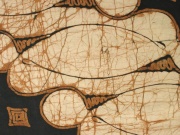Difference between revisions of "Resist-dyed textile"
Jump to navigation
Jump to search
| Line 4: | Line 4: | ||
A traditional method to apply colors or patterns to textiles. A 'resist' is used to prevent the dye from accessing specific areas of the cloth. Resist methods include: | A traditional method to apply colors or patterns to textiles. A 'resist' is used to prevent the dye from accessing specific areas of the cloth. Resist methods include: | ||
| − | * Tie dye: One method involves pinching a portion of fabric then tying it tightly with a waxed thread. The fabric is dyed, then the | + | * Tie dye: One method involves pinching a portion of fabric then tying it tightly with a waxed thread or rubber bands. The fabric is dyed, then the ties are removed revealing circular areas of the original fabric. The process can be repeated with multiple colors. It has been used extensively in India where it is called 'bandhani'. An alternate method stitches or folds the cloth in a pattern, like a fan, then places the ties in intervals. |
| − | * Applied resist: | + | * Applied resist: A method in which a resistant material such as rice paste (tsutsugaki), beeswax (batik), soot (pouncing), mud, etc. is applied in patterns to the fabric to prevent the dye from reaching sections. The resistant material is then removed leaving the original fabric. |
| + | |||
| + | * Screen print: A method that uses a physical shield, such as a stencil to protect the fabric as the dye is applied. Repeated printings with separate stencils are used to create multi-colored patterns. | ||
Examples include bandu, [[batik|batik]], [[ikat|ikat]], and [[shibori|shibori]]. | Examples include bandu, [[batik|batik]], [[ikat|ikat]], and [[shibori|shibori]]. | ||
| Line 23: | Line 25: | ||
</gallery> | </gallery> | ||
| + | == Resources and Citations == | ||
| + | * Victoria and Albert Museum: http://www.vam.ac.uk/content/articles/r/resist-dyed-textiles/ (Accessed October 20, 2020) | ||
| + | * Lovetoknow: https://fashion-history.lovetoknow.com/fabrics-fibers/resist-dyeing (Accessed October 20, 2020) | ||
| + | * Wikipedia: https://en.wikipedia.org/wiki/Resist_dyeing (Accessed October 20, 2020) | ||
[[Category:Materials database]] | [[Category:Materials database]] | ||
Revision as of 09:39, 20 October 2020
Description
A traditional method to apply colors or patterns to textiles. A 'resist' is used to prevent the dye from accessing specific areas of the cloth. Resist methods include:
- Tie dye: One method involves pinching a portion of fabric then tying it tightly with a waxed thread or rubber bands. The fabric is dyed, then the ties are removed revealing circular areas of the original fabric. The process can be repeated with multiple colors. It has been used extensively in India where it is called 'bandhani'. An alternate method stitches or folds the cloth in a pattern, like a fan, then places the ties in intervals.
- Applied resist: A method in which a resistant material such as rice paste (tsutsugaki), beeswax (batik), soot (pouncing), mud, etc. is applied in patterns to the fabric to prevent the dye from reaching sections. The resistant material is then removed leaving the original fabric.
- Screen print: A method that uses a physical shield, such as a stencil to protect the fabric as the dye is applied. Repeated printings with separate stencils are used to create multi-colored patterns.
Examples include bandu, Batik, Ikat, and Shibori.
Synonyms and Related Terms
resist dyed textile; resist dyeing;
Additional Images
Resources and Citations
- Victoria and Albert Museum: http://www.vam.ac.uk/content/articles/r/resist-dyed-textiles/ (Accessed October 20, 2020)
- Lovetoknow: https://fashion-history.lovetoknow.com/fabrics-fibers/resist-dyeing (Accessed October 20, 2020)
- Wikipedia: https://en.wikipedia.org/wiki/Resist_dyeing (Accessed October 20, 2020)




